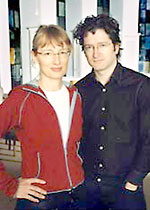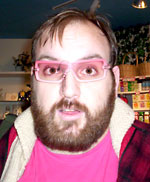

JACKET INTERVIEW
Janet Cardiff
in conversation with
Anthony Easton
2006
This piece is about 5 printed pages long
Janet Cardiff sculpts words into private dramas and public rituals, using performances that are intensely logophillic, but refuses to call herself a writer. Sometimes this comes intimately, in the ear buds of Discmen or Ipods, telling one how, where to walk, and for which purposes to walk. Sometimes it comes by pounding tables that respond by cleverly placed electronics, or standing in the midst of 40 speakers, as they separate and combine, electronically, the 40 parts of the Elizabethan composer Thomas Tallis’ Motet Spem in Alen.

Janet Cardiff and George Bures Miller. Photo by Gunnar Geller.
Photo courtesy Ontario College of Art and Design.
Like how she fractures the language of Tallis in both volume, and speed, her precedents move in intensity and effect. Hearing her praise Vito Acconici takes the shock out of his Seedbed performance, and replaces it with a respect for his silence, his desperation and his sadness. Her respect for Linda Montana reminds us of how language is really about rituals and communication, where the words used are not written or found, but come from daily living (daily living in strange circumstances sometimes, this was a woman who spent all of her public life for an entire year tied to another person) Finally, her naming of Marina Abromovitch connects to an abject destruction of one’s body.
The strange thing is that each of these people cares deeply about shocking, isolating, or violating their audiences. Caridff is gentle and almost sweet compared to these folks, her use of words is a conversation, and intercessed with technology, with half completed discourses, and abstracted performances. Though she refuses to play into taxonomies, there is a poet somewhere there. Even if that poet stubbornly thinks that a writer is words on the page, or that words cannot feature three dimensions.
The theses confronted in this interview center around questions of writing’s relation to performance. Her use of technology renews this age-old debate. I am reminded of something that the singer and songwriter Stephin Merritt wrote. He said that there was nothing new in dance music recently, because what was always new about it was being on the forefront of electronic instruments and there was nothing new there recently. Cardiff’s new use of words is on the forefront of linguistic usage, for the same reason that Merritt’s musical pioneers have failed the avant-garde, because she is on the bleeding edge of new ways of working.
I don’t consider myself a writer. I just write down my thoughts or things that I’ve read or heard and collage them together. The second step is to speak them aloud because literary sentences don’t work in an aural way. The last in the process is to then take the words for a walk. Writing is like a 3-Dimensional process for me. The words and sentences have to work with a physical space, resonate with that space. One thing works on the page but it’s a different thing when they are juxtaposed with a physical environment.
Long questions. So I will break them up. The connection I feel to performance people is the connection that especially a lot of the ’70s artists have to the audience. It’s a very direct connection, an intimate one. Linda Montano was an inspiration in her attempts to investigate intimacy and new formats. Vito Acconci’s voice is the greatest. It is almost a physical object that becomes separate from the person. This is important to me as well. Marina Abromovitch’s ability to make an audience very uncomfortable and very aware of their own bodies has always been inspiring. I don’t relate to a lot of object art. Paintings are nice to look at and to contemplate but I think my investigations are much more aligned to artists that somehow involve the audience emotionally and in a physical way.
I have always been a hybrid artist, connecting with literature and theatre sometimes more than the traditional arts so divisions don’t make sense with me. The division to me is much more about art that is interested in transporting or involving the audience and art that isn’t — art that is more just visual or conceptual involvement.
Listeners/ viewers have told me that they feel very intimately connected to the voices in ‘The Forty Part Motet’ in much the same way as the walks. Also my interest in the virtuality of the voice, or the ghostly presence is very similar in all the works, the installations and the walks. In all of them the listeners are very directed in how they move but in the Motet it is a piece that is much more related to sculptural sound. Forty speakers of 24bit audio hitting your body cannot be ignored. The walks are also physical sculptures through time and space but they evolve in a narrative way. So I would have to say that the narrative/ filmic content is really the main difference between the walks and the Motet.

‘The Forty-Part Motet’, 2001, installed at Kunsthaus Bregenz, Bregenz, Austria. Photo: Markus Tretter. Copyright Janet Cardiff and George Bures Miller, used with permission. Photo courtesy Ontario College of Art and Design.
I like to use technology that is easy to understand and access. The background tech may be very complicated and high but the presentation to the audience should be something that they are very comfortable with… consumer tech. Discmans, ipods, speakers. I like that the technology is so popular it is almost invisible so that people can become intimate with it. At the same time the recorded voice is removed and has a sense of past that a real voice doesn’t, so it can actually get closer to the audience through that removal. They feel safe being intimate with a removed voice.
The Forty Part Motet has 8 choirs of 5 voices each set up in an oval so that the structure of the composition is very apparent. You can almost see the movement of the music in the room around you. That was a very deliberate choice. In To Touch the speakers needed to also be spread out around the room because the sound had to be perceived to be coming from all around the listener in a sculptural way. It uses 16 tracks of surround sound but the speakers are hidden in darkness. Immersion in the sound is very important for installations as well as sound being able to define space.
I’ve started to use Ipods now as they are cheap enough as well as they have better amplifiers than Discmans. The government made rulings that forced the Discman companies to decrease the volume of their amplifiers. Because I use subtle sound as well as loud sound, a real range, it made it impossible for me to use them in the last few years. Ipods have a setting that parents can set to control volumes if they want to.
It’s a different piece in each setting because of the context of course but also the acoustics vary and in some areas are much better than other spaces. The Rideau Chapel is of course a religious context, which makes it a different piece than at the MOMA where it was a very sparse space. But the sound quality of the Chapel was better because of all of the wood. I’ve found that listeners either prefer one or the other. It’s all personal taste.
I’m not a writer so I would never position myself as that. I’m actually a very bad writer if you are just reading the material. So I think I would fail at that. It’s like Hitchcock said… don’t make a movie with a good book, because it’s already found its format. I write only thoughts that definitely aren’t literature in that they don’t function in the format of literature. It’s very difficult to make it as an artist as well. 30,000 MFA graduates come out every year in the states alone. Perhaps 100 of these can live off their art and perhaps 3 make it internationally. So no I don’t think it’s easier in the structures of the art world. It’s just that poetry has a much more private audience because reading is a private activity.
Yeah. I deliberately ignored it. Didn’t know what you were referring to.
I will use an example of a collage I did for a street in London for the piece The Missing Voice. I researched the history of the street and found out about people who had lived there, what had happened. et cetera. One person was a man who played his violin every day to put in the hours while he waited for his wife to come back. She had left him but would come back occasionally. I used this source material to write a short description of his situation and I recorded a violinist to play in the background at this point. I also read about bombs from the IRA that had gone off in the area. This coincided with the brick lane bombing that happened 10 minutes after I had walked past where the bomb went off. So I created a scene that had people running and screaming, SFX (Sound Effects) like the siren from the blitz, a helicopter passing, machine gun fire, and bombs going off. At the end of this I used a quote from Daniel Defoe writings describing the plague in the area. I like to use sound mixed with historical quotes mixed with my writings from research sources and fictional scenes to create the effect of many different time periods, mixing the recent past with history and the present.
I’m not from Alberta. I lived there for ten years. Plus the three we lived in Edmonton was for school and I couldn’t wait to get out because of that uptight atmosphere. My most influential landscape is the rural Canadian. A sense of privacy and walking is important to me. I don’t really relate to prairies though. I like hills. In Lethbridge the coulees were my refuge to the rest of the place.

Anthony Easton
Anthony Easton is an essayist, poet, critic, curator and
photographer. He is interested in issues of memory, language, absences, theology, and the body.
He lives in Edmonton, Canada. His blog is www.pinkmoose.blogspot.com and his photos can be seen at www.flickr.com/photos/pinkmoose